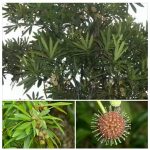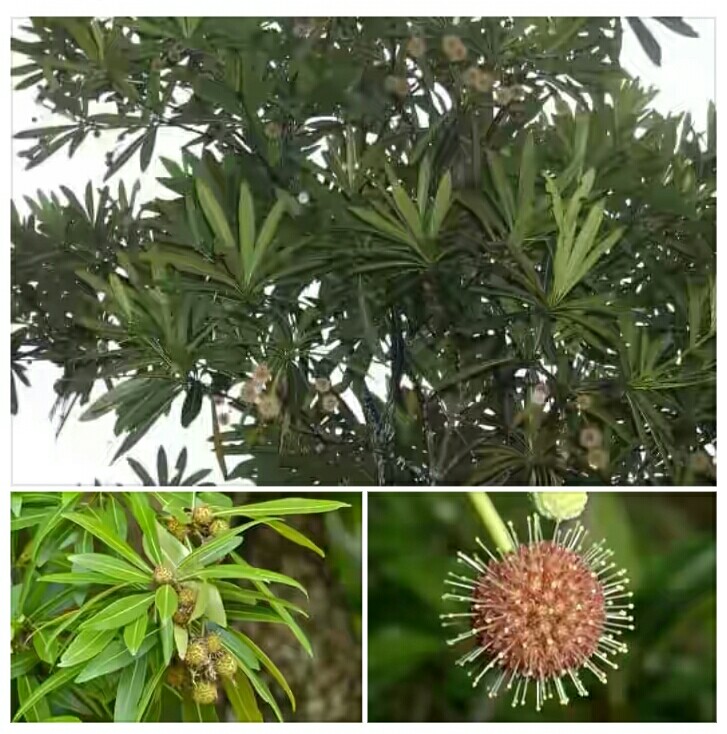Breonadia salicina; synonyms: Breonadia microcephala, Adina microcephala (Botanical name) or Water shea nut, African teak, Transvaal teak, Wild oleander, Mingerhout, Matumi (English) or Hakorin babbauniya, Kaɗanyar kurmi (Hausa): A large evergreen tree with many uses
DESCRIPTION AND OCCURRENCE: Breonadia salicina is a small to large evergreen tree, 10 to 40 m tall. When the tree is mature the base becomes thick, with grey to grey-brown, longitudinal, rough bark ridges throughout the trunk. Lateral branches are arranged in groups.
Leaves usually occur in whorls of 4 and crowded at the ends of the branches, are simple, lanceolate (narrow oval shape, tapering to a point at each end) to narrow elliptic 80-300 × 20-90 mm, tough leathery, glossy green, hairless, pale below, with midrib and lateral veins pale yellowish green. The flowers occur in 15-25 mm diameter, spherical, compact heads, made up of numerous, minute, pale mauve flowers.
The head of flowers is on a slender stalk, 20-95 mm long, and has 2 leaf-like bracts below the head of flowers. Each flower has a tubular, five-lobed corolla, widening to a funnel-shaped throat, flared at the mouth. Stamens are attached to the throat and the flowers are sweetly scented. Fruit is a ball of small, brown, 2-lobed capsules, 2-3 mm long, densely packed into rounded heads and having a rough, bristly appearance.
In Benin, trees flower in February-August, and fruits ripen in June-September. In southern Africa, flowering is in November-March and fruiting in June-July. Seeds are 2-3 mm long. Breonadia salicina is found in riverine fringe forest, along or in water of permanent streams and rivers, occurring at low altitude, in tropical and subtropical regions.
Breonadia salicina is widely distributed in tropical Africa, from Côte d’Ivoire and Mali eastward to Ethiopia, and southward to Angola, Zimbabwe, Mozambique and Madagascar. It also occurs in South Africa, Swaziland and Yemen. It is sometimes planted.
USES: The twigs are used for cleaning the teeth in West Africa. Breonadia salicina is often planted as an ornamental tree and sometimes also for erosion control and in windbreaks.
The flowers serve as bee forage. In Madagascar the bark is added in the preparation of local alcoholic drinks (‘toaka gasy’) to help fermentation. Breonadia salicina is widely used in traditional African medicine. Root decoctions are drunk as a purgative in Tanzania and against tachycardia in South Africa.
An infusion of the pounded stem is given to breast-fed children in Ethiopia for the treatment of diarrhoea and vomiting. In Tanzania bark infusions are used for preventing influenza and for the treatment of stomach problems, and a decoction or infusion of the bark is used as a wash to clean wounds. Dried powdered bark is applied as a wound dressing. In Malawi the bark is chewed for the treatment of diarrhoea and stomach-ache, and a bark infusion is drunk for the treatment of pneumonia.
In Madagascar a decoction of the inner bark is used as a mouthwash in case of cavities and abscesses. A leaf decoction is used in Nigeria as a bath for the treatment of yellow fever. In Malawi a leaf infusion is drunk to treat diarrhoea and stomach-ache.
In Madagascar a leaf decoction is drunk for the treatment of malaria. In Ethiopia the seed is put into fire and the patient exposed to the smoke to treat joint pain. In veterinary medicine in Nigeria, the bark is used against diarrhoea. In Nigeria the root and bark are ingredients of arrow poisons on the basis of Strophanthus sarmentosus DC.
The wood is suitable for heavy construction (including bridges), heavy flooring, joinery, mine props, boat building, vehicle bodies, furniture, sporting goods, toys, novelties, agricultural implements, railway sleepers, marine piles, carvings, pattern making and turnery.
It is made into bows in Nigeria, for caskets in Madagascar, while in Malawi and Madagascar dugout canoes are made from the boles. In southern Tanzania the wood is extensively used as fuelwood.
FOR FURTHER READING SEE:
1. Arbonnier, M., 2004. Trees, shrubs and lianas of West African dry zones. CIRAD, Margraf Publishers Gmbh, MNHN, Paris, France. 573 pp.
2. Neuwinger, H.D., 2000. African traditional medicine: a dictionary of plant use and applications. Medpharm Scientific, Stuttgart, Germany. 589 pp.

These are the thoughts and intellectual property of:
Sa’eed Halilu Bawa
Senior Lecturer (Associate Professor) at University of the West Indies, St. Augustine Campus, Trinidad.
Studied Food and Nutrition Sciences, Dietetics at Kaduna Polytechnic, Nigeria; Warsaw University of Life Sciences, Poland.
























